The landscape of cinema is undergoing a revolutionary transformation as interactive technologies reshape how we experience storytelling on screen. From interactive narratives that allow viewers to make choices to immersive experiences that blend gaming mechanics with cinematic storytelling, this emerging field represents a significant shift in both filmmaking and audience engagement. This comprehensive resource collection brings together key books, academic articles, and research papers that explore the intersection of traditional cinema with interactive digital technologies, offering insights into both the theoretical frameworks and practical applications of this evolving medium.
Interactive Film Resources
Technologies that were initially developed to be applied within the domain of video games are currently being used in experiments to explore their meaning and possibilities for cinema and cinema audiences. In this position paper we examine how narrativity, interactivity and engagement are mutually reshaped within this new domain of media entertainment, addressing both the production and the user experience of new types of interactive cinematography.
BOOKS
Interactive Digital Narrative
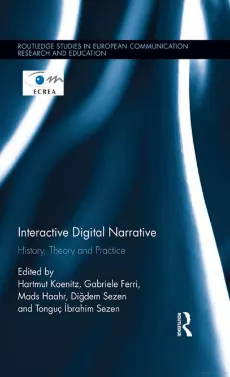
Click here to access the book.
Description of the book:
The book is concerned with narrative in digital media that changes according to user input—Interactive Digital Narrative (IDN). It provides a broad overview of current issues and future directions in this multi-disciplinary field that includes humanities-based and computational perspectives. It assembles the voices of leading researchers and practitioners like Janet Murray, Marie-Laure Ryan, Scott Rettberg and Martin Rieser.
Hyper – Narrative Interactive Cinema

Click here to access the book.
Description of the book:
Hyper narrative interactive cinema refers to the possibility for users or "interactors" to shift at different points in an evolving film narrative to other film narrative trajectories...
The Educational Technology Anthology Series – Interactive Video
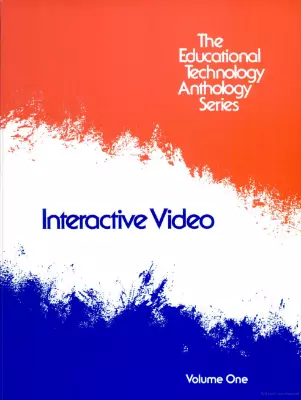
Click here to access the book.
ARTICLES
Black Mirror: Bandersnatch and how Netflix manipulates us, the new gods
Click here to access the article.
Description of the book:
This film review of Black Mirror: Bandersnatch, released by Netflix in 2018, discusses the nature of the interactive genre, focusing on its current and future effects on data mining, product placement, and programmatic advertising, highlighting the new, evolving role played by the viewer.
Interactive Dramaturgies: New Approaches in Multimedia Content and Design

Click here to access the article.
Abstract of the article:
Interactive media allow and at the same time require new forms of dramaturgy. Heide Hagebölling develops a new understanding of dramaturgy - so-called "Interactive Dramaturgy" or "Expanded Dramaturgy"...
To watch from distance: An interactive film model based on Brechtian film theory
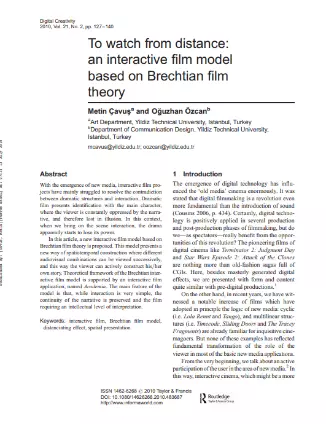
Click here to access the article.
Abstract of the article:
With the emergence of new media, interactive film projects have mainly struggled to resolve the contradiction between dramatic structures and interaction...
Cinematic interaction: From kinoautomat to cause and effect
Click here to access the article.
Abstract of the article:
The world's first interactive movie was created in Czechoslovakia and called Kinoautomat...
Interactive Cinema: Engagement and Interaction
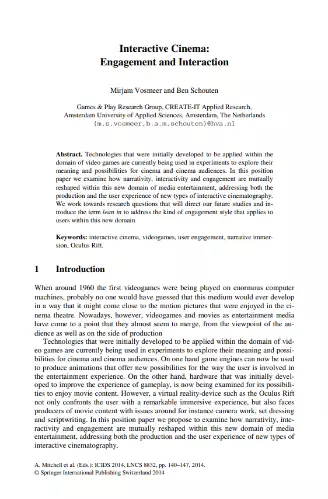
Click here to access the article.
Abstract of the article:
Technologies that were initially developed to be applied within the domain of video games are currently being used in experiments to explore their meaning and possibilities for cinema and cinema audiences...
What might arise from reconsidering the concept of interactive film?
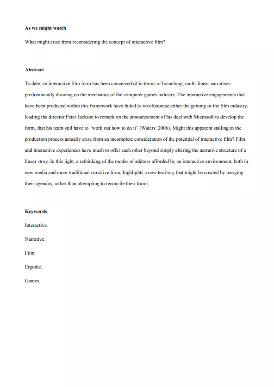
Click here to access the article.
Abstract of the article:
To date, an interactive film form has been conceived of in terms of branching...
Tools for an interactive virtual cinema
Click here to access the article.
Abstract of the article:
This paper describes our experiments with narrative structure in nonlinear, interactive and networked forms of media...
Real-time Cinematic Camera Control for Interactive Narratives
Click here to access the article.
Abstract of the article:
New interactive media works based upon audio-visual material often result in distraction rather than sustained engagement...
